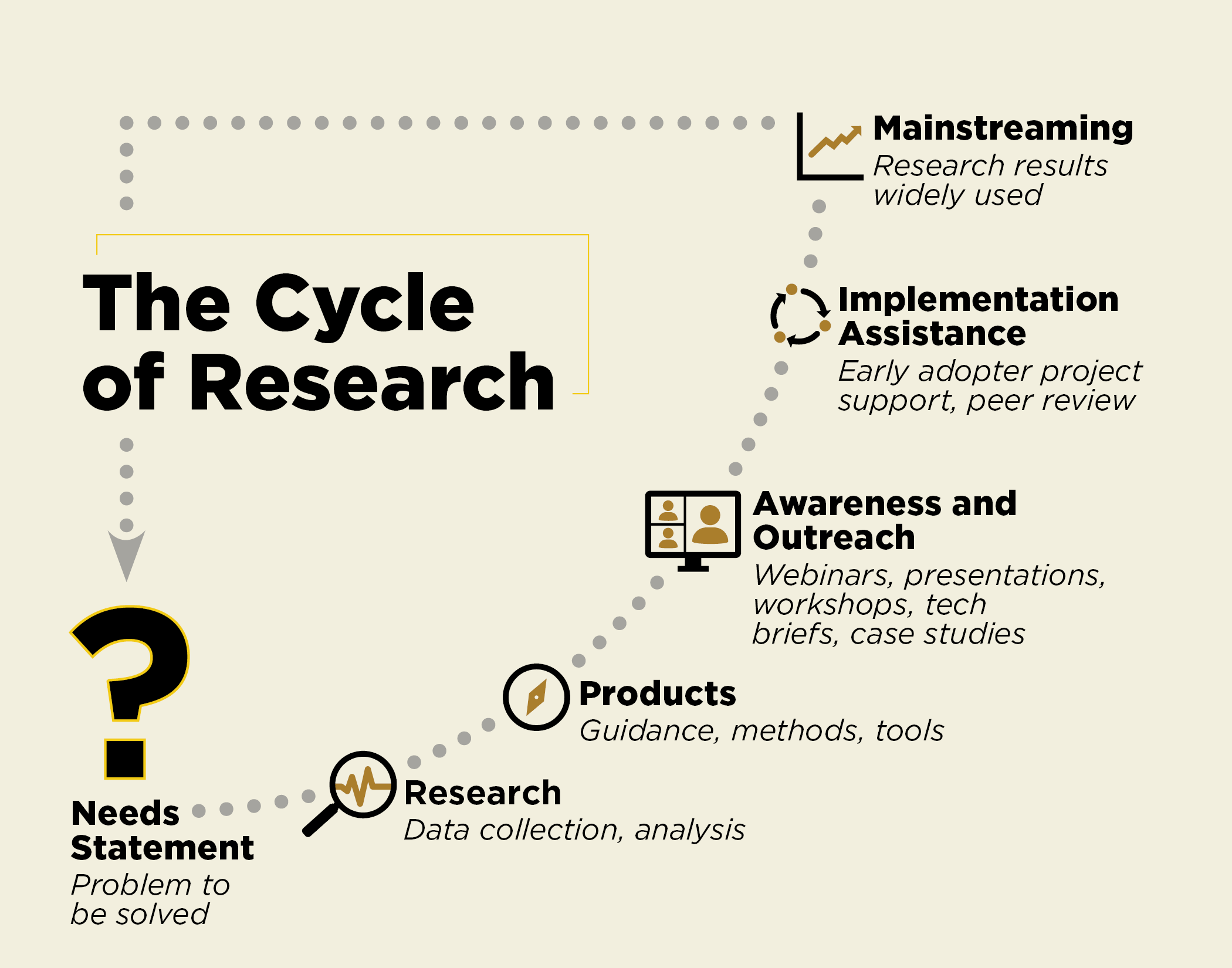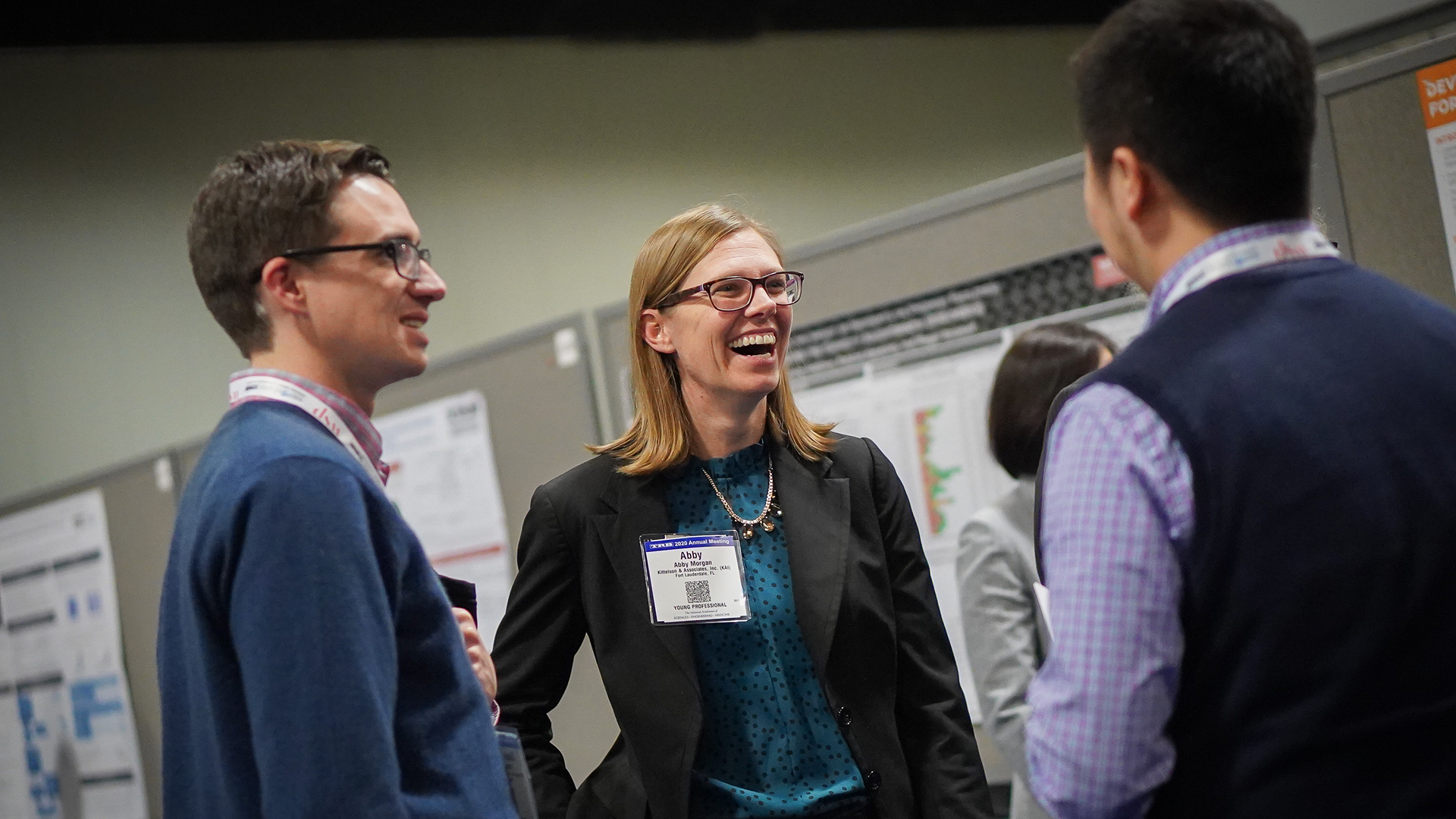December 9, 2022
From January 5 to 9, 2025, more than 13,000 researchers and practitioners will gather in the Walter E. Washington Convention Center for the 104th Annual Transportation Research Board (TRB) Annual Meeting.
An incalculable amount of activity takes place in those five days, and we at Kittelson are excited to send a cohort of more than 60 team members to participate in the transportation research community’s biggest event of the year. Research projects take center stage at the TRB Annual Meeting, from presentations on completed efforts to the generation of new ideas. At workshops and committee meetings, researchers and practitioners alike will put our heads together to identify our profession’s most pressing research needs. These research needs will go on to become the next cycle of research projects and ultimately, published guidance.
Where does that published guidance go next? We all have a role to play.

To reach its full potential for impact, research needs to make it into the hands of practitioners. Pictured: a poster session at a TRB Annual Meeting.
The Cycle of Research and Implementation
Let’s begin by examining the life cycle of a research project. We think of research as a cycle.

Think about how many updates you’ve installed on your smartphone since purchasing it. Research is similarly iterative. Applying research to projects alerts us to limitations, inconsistencies, and questions that go on to inform ideas for new research. We refer to these ideas as needs statements.
The TRB Annual Meeting touches on all steps of this cycle, but one of the primary benefits of bringing together the members and friends of nearly 200 committees into one buzzing convention center is the generation of needs statements. These ideas ultimately go through AASHTO’s Special Committee on Research & Innovation for voting to become NCHRP research projects.
Most research projects are funded through the products stage-a guidebook or tool gets published and becomes widely available. Many of these guidebooks provide thorough methodologies and detailed guidance addressing some of our profession’s biggest questions.
However, just because a guidebook is available does not mean it will be used by practitioners. Changing the state of practice is hard. Even when research projects are taken into the awareness and outreach stage of the research cycle, it typically requires more than a news post, webinar, or training for the findings to make their way into industry practice.
We are excited to see more formal and funded ways to get research off the shelf and onto the ground. NCHRP 20-44 is one program leading the way to propel research into implementation assistance and ultimately mainstreaming.
Even when research projects are taken into the awareness and outreach stage of the research cycle, it typically requires more than a news post, webinar, or training for the findings to make their way into industry practice.
NCHRP 20-44: Closing the Gap Between Research and Practice
Research is conducted so that it can be implemented. On their website, the National Cooperative Highway Research Program (NCHRP) puts it this way: “NCHRP publishes the research results and delivers implementable products. The benefits from the project findings, however, begin with implementation by state DOTs and other transportation agencies.”
The NCHRP Implementation Support Program, which is part of NCHRP Project 20-44, was developed for this very purpose: getting research past awareness and into practice.
The NCHRP 20-44 panel, whose members represent both agencies and academia, reviews applications and allocates funding for activities to implement research findings. The activities range from workshops and peer exchanges to pilot projects. The panel keeps an eye out for projects that are feasible, impactful, and scalable to serve as the gateway to get research further mainstreamed.
For an example, we can look to the Oregon Department of Transportation (ODOT) Statewide Pedestrian and Bicycle Plan, which was developed using implementation funds from NCHRP Project 20-44. The project team, led by Kittelson’s Nick Foster, applied NCHRP Research Report 893, Systemic Pedestrian Safety Analysis to analyze ODOT’s highway network for pedestrian and bicyclist safety.
Using NCHRP Report 893’s seven-step systemic safety process, the team identified 50 high-risk locations for pedestrian and bicycle crashes on state highways and developed countermeasures. The results will be used to update the state’s Highway Safety Improvement Program (HSIP) project selection process for future systemic bicycle and pedestrian safety projects. More broadly, the results set an example for other DOTs to apply NCHRP Report 893 when analyzing their own highway networks.
How to Get More Research on the Ground
All of us in the transportation profession have a role to play in building off the momentum of initiatives like NCHRP 20-44 and incorporating new research into our projects.
All of us in the transportation profession have a role to play in building off the momentum of initiatives like NCHRP 20-44 and incorporating new research into our projects.
From the research side:
As researchers, it is our duty to keep implementation in mind throughout the research cycle so that we develop guidance that agencies can put into practice. Collaboration between researchers and practitioners is critical. The final research product needs to be practitioner-oriented, easily understood, and applicable to real projects.
From the public agency side:
If you’re reading this on behalf of an agency, here are three effective ways to advance the implementation of transportation research in your jurisdiction:
- Make research implementation a project. The best way to learn about new methods is to apply them. An implementation project, like those funded by NCHRP 20-44, provides an opportunity to pilot new research on real corridors and intersections.
- To make this happen, contact the research program officer within your agency and ask about available implementation funds and how to tap into those funds.
- Finally, you need an agency champion. This is perhaps the most important ingredient of successful research implementation. A champion is someone paying attention to the latest research and motivated to apply it to their community, so that when challenges arise, the project still moves forward.
From the consulting side:
As consultants, we feel lucky to work in a dual capacity-developing research then applying it to our projects. We are passionate about the guidance we produce for local governments and state DOTs. And we get excited about opportunities to implement that research in local projects through further collaboration with these agencies.

Kittelson's Abby Morgan presents a research poster at a TRB Annual Meeting.
At Kittelson, we’ve structured our firm around connecting research and implementation. We build project teams that bring together staff with strong research backgrounds and project-oriented team members who represent the end user of the research. Even those who are on research career tracks in our firm still dedicate about a quarter of their workload to local projects and implementation.
As consultants, we also help our clients develop nontraditional funding routes to take research into implementation. Earlier this year, we advised two project applications competing for New York State Energy Research and Development Authority (NYSERDA)‘s Clean Transportation Prizes. These prizes provide pilot funding for emerging technologies, which because of their newness, may not yet have a proven track record of success to attract funds. These pilot projects can in turn, feed back into research, sharpening our understanding of what works, what doesn’t, and what might radically change the transportation landscape if only given the chance.
Let’s Talk at TRB 2025
We know we’re not the only ones who are passionate about the connection between research and implementation. It’s an honor to collaborate with agencies, academics, and other consultants year-round to conduct the research that will shape our profession while also looking for ways to apply the research that’s already on the shelf. This collaboration will be front and center at the 2025 TRB Annual Meeting, and we’re looking forward to being a part of it. If you’ll be at TRB 2025, we’d love to connect. View our schedule here, and let’s set up time to meet!
